“For the people who used to be ten years old, and the people who are going to be ten years old.”
The films of Studio Ghibli provide their viewers with a rich variety of female characters from warrior princesses to love-struck adolescents, curious toddlers to powerful witches. These characters owe a great deal to the prototypes of European fairy tales and Japanese folklore and in many ways are traditional versions and depictions of femininities, but there’s an underlying sense of joy for feminist viewers in that these girls and women are active, subjective and thoroughly engaging. I’m focusing here on young girls in the lighter end of Ghibli’s production including sisters Mei and Satsuke in My Neighbour Totoro, Kiki in Kiki’s Delivery Service and Chihiro in Spirited Away.
 |
||||
| Spirited Away |
Ghibli films tend to blend fantasy and reality so that magic and flight are acceptable parts of the worlds the characters inhabit. Girls especially tend to possess magic powers or particular appreciation of them and this is shown in an unexceptional manner. While Kiki raises some eyebrows in her new town, it’s because the townsfolk don’t see many witches, not because they don’t believe in their existence. Similarly, although Kiki is an outsider, there is a distinct lack of threat to her for being so. In Ghibli worlds girls are fully entitled to fly on broomsticks, as long as they don’t congest traffic, and 13 year olds are allowed to pursue their cultural practices of living alone. In My Neighbour Totoro when Mei tells Satsuke and their father about her encounter with Totoro, after initial disbelief they embrace the truth that there are friendly nature spirits in the area, even leading to father taking the girls to pay their respects to the forest’s deities.
This acceptance of magic is refreshing and marks a clear difference to American cartoons where ironic references are embedded in children’s fantasy to appeal to parents. In this way parents are encouraged to indulge, but secretly laugh at their children’s engagement with fantasy. There’s no knowing irony in Ghibli films, instead they are focussed on telling children’s stories for children and the lack of distinct boundaries between the magic and the mundane are part of this child-centred view. That the protagonists are predominantly female makes for a collection of films focussed on girls’ adventures and triumphs where girls’ experiences are trusted and valued.
Children, like women, are often depicted as having a close connection to the supernatural; that they can see things the rest of us cannot. Indeed Mei and Satsuke seem privileged more than anything to be invited to join the Totoros’ night-time nature ritual. Dancing and flying with creatures the rest of the world (the Ghibli world at least) would revere but aren’t lucky enough to encounter. Chihiro doesn’t have a natural affinity for magic but she’s gifted in the solving of magical problems like how to clean a dirty river spirit.
Mei, Satsuke, Kiki and Chihiro all work within the magical world as part of their quest narratives. Mei and Satsuke are dealing with the illness and potential death of their mother and a move to a new home. Kiki has moved away from her parents according to witch culture and Chihiro seeks the return of her parents from the spiritual realm where she’s been trapped and they’ve been turned into pigs.
 |
| My Neighbor Totoro |
The absence of parents is a common way to allow independence to young females from fairy tales to Jane Austen and unlike for orphaned boys in fiction it can also represent a removal of patriarchal influence in general. It’s not just that these girls don’t have parents guiding them or checking up on them; they are also free to create their own rules of engagement with the world.
One way that all four girls find meaning and self is through work. Satsuke in school and house work, Mei despite being very young does gardening, Kiki sets up her delivery service and Chihiro works in the bath house. All of them do a lot of cleaning. There’s an interesting mix of public and private here and certainly the suggestion that domestic labour can be especially rewarding (for example Kiki’s paid work can provide anxieties and problems). But is the culturally feminine nature of this work an issue? In Chihiro’s case cleaning is linked to subservience and being a captive to the domestic but for the others (and eventually for her) it’s a tool of empowerment and liberation. Does such labour inevitably have negative associations of female drudgery?
Another way that selfhood and identity is achieved by these girls is by flight. Most obviously for Kiki where her broomstick is literally the means of earning a living and saving a friend’s life but also in how Totoro and Cat Bus fly Mei and Satsuke away from their worries and later to their mother. Chihiro’s flight is more anxious, as her encounters with magic are generally, but still serves to move her closer to self discovery by being the time she gives Haku his name so leading her to the rediscovery of her own.
 |
| Kiki’s Delivery Service |
Not everybody believes that Ghibli heroines represent empowered femininities. I’ve been rather selective in the choice of films to cover but even if I’d widened the selection I stand by my view. Ponyo for example wasn’t included as its heroine isn’t really a girl but although it’s a variation on the disempowering The Little Mermaid the core message is rather different. Ponyo accepts a loss of powers because they were never entirely hers and the sea’s power remains with the feminine; Ponyo’s sea-goddess mother.
There’s been significant note of the glimpses of knickers we get in Ghibli films like when Kiki is flying and generally when there’s any rough and tumble. There’s merit in the argument that this could be voyeuristic representations of young girls but it can also be seen as further expressing their freedom and activity. These girls don’t worry about skirts riding up because they totally lack vanity and are preoccupied with altogether more important missions. We’re not given alluring peeps at nubile bodies but girls in action which female bodies so rarely are; that gaze is usually reserved for male bodies. If female passivity is alluring then the kinetic energy of these girls places them beyond that.
What’s pleasurable about these films from a feminist perspective is their alliance with joyful, engaged and active girlhoods. These girls don’t wait for princes and don’t focus on their appearances but determinedly pursue their missions, however difficult.
———-
Rosalind Kemp is a film studies graduate living in Brighton, UK. She’s particularly interested in female coming of age stories, film noir and European films where people talk a lot but not much happens.






